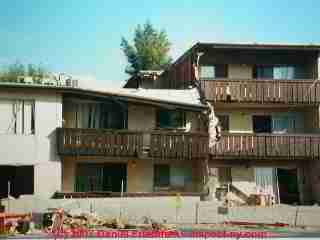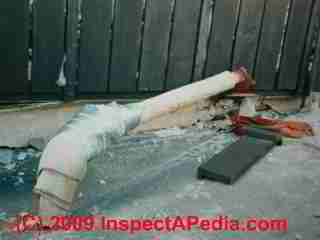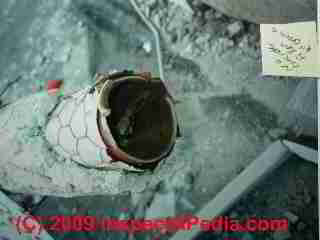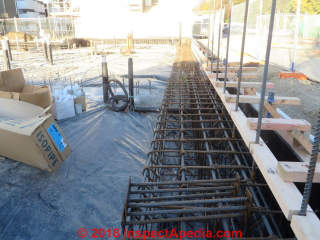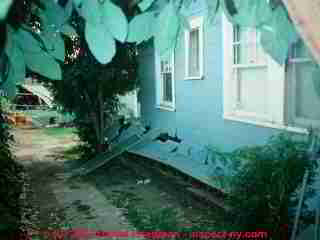 How to Detect, Diagnose, & Evaluate Earthquake Damage
How to Detect, Diagnose, & Evaluate Earthquake Damage
Earthquake-Damaged Foundations, Structures, Chimneys, Mechanical Systems
- POST a QUESTION or COMMENT about how to recognize, diagnose, evaluate, and repair building foundation damage due to earthquake activity
Foundation damage due to earthquake activity:
This article describes how we recognize different types and causes of complex or combined building foundation movement & foundation damage. Earthquakes shake building structures in different patterns, sometimes unique to a particular quake.
The basic earthquake-generated forces that operate on buildings are side to side, up and down, or a combination of these. But depending on which forces are exerted, buildings shift and structural components fail in different patterns. Here we describe different damage patterns observed in building foundations or structures due to several different types of earthquakes.
InspectAPedia tolerates no conflicts of interest. We have no relationship with advertisers, products, or services discussed at this website.
Combinations of Building Foundation Movement due to Earthquake, Flood, or Storm Damage
 The photographs of earthquake-damaged building foundations and structures shown here are rather dramatic (and terrible as there were certainly fatalities in these buildings). More subtle is the detection of small movements, not immediately obvious, that break gas mains or cause other dangerous building conditions following an earthquake.
The photographs of earthquake-damaged building foundations and structures shown here are rather dramatic (and terrible as there were certainly fatalities in these buildings). More subtle is the detection of small movements, not immediately obvious, that break gas mains or cause other dangerous building conditions following an earthquake.
Here we distinguish among vertical movement, horizontal movement, leaning, tipping, bending, differential and uniform settlement, earthquake and storm damage, and other foundation damage patterns.
This article series describes how to recognize and diagnose various types of foundation failure or damage, such as foundation cracks, masonry foundation crack patterns, and moving, leaning, bulging, or bowing building foundation walls.
To be used properly, this information must be combined with specific on-site observations at the particular building in order to form a reliable opinion about the condition of that building's foundation.
Watch out: Anyone having concern regarding the structural stability, safety, or damage of a building, foundation or other components, should consult a qualified expert.
Types of building movement: Northridge Earthquake 1994
As we describe here, the effects on buildings and how they moved or collapsed. Some building sections collapsed straight down while others were levered sideways by their supporting columns, moving sideways for a distance about equal to the height of the failing columns.
Types of building collapse or movement depended on both the combination of directions earthquake forces and construction details of individual buildings.
At the 1994 Northridge Earthquake in Los Angeles, a very strong lateral shift was visible on many buildings.
Force was sufficient to shift some entire buildings sideways in distances ranging from just an inch or so (broken gas mains, gas explosions, fire, burst water mains) to distances up to eight feet (where buildings were leveraged sideways as supporting columns failed). We observed:
- Vertical building collapses
- Horizontal building shifts, leans, tilts.
- Combined horizontal shift followed by vertical collapse of buildings. A lateral or horizontal movement that damaged building supports then led to both straight-down vertical collapses as well as combined horizontal movement followed by vertical collapse
1. Vertical Building Collapses due to Earthquake
The Northridge Earthquake in Los Angeles, California in January 1994 caused extensive damage as well as fatalities when buildings were shifted off of their foundations, leading to catastrophic collapse in some cases.
These photographs taken by the author at Northridge Meadows, a site of some of the worst fatalities, shows a section of building that collapsed straight down, compressing the first floor (and some occupants) to just a few inches.
The left portion of the photo shows a third floor balcony aligned with the second floor balcony of a building segment that did not collapse. Earthquake resistant construction has as a primary objective to prevent just this sort of collapse, as an effort to reduce the number of injuries and fatalities from an earthquake.
Examination of construction details such as the sequence of original construction and the failure to continue staggered plywood sheathing and continuous floor joist framing appeared to explain why the right-hand portion of the building stood while an entire floor of the left-hand building section collapsed, killing occupants of the first floor.
2. Horizontal Building Movement due to Earthquake
But there were more subtle failures at work - hollow steel pipes that failed where concrete-filled steel Lally columns should have been installed.
The bent steel column (photo at above left) illustrates how a failing structural column, supporting foundation wall, or supporting knee wall can also lever a building sideways for a distance approximately equal to the column height.
Our photo above shows one of the bent, failed Lally columns. The building wall in the background of the photo was previously supported on top of this column.
This photograph was taken at the rear of the apartment building shown in the pair of photographs above.
Below our photograph shows that the bent Lally column top shows that the column was hollow.
Like other Lally columns that bent over completely leading to building collapse and sideways shift, this column had been wrapped in a fire-barrier coating.
An external inspection of the column after construction could not, without more sophisticated testing, disclose that the builder had use hollow steel rather than a properly-constructed concrete-filled column.
Structural engineers and experts with more experience than the author have examined this catastrophe. But we thought it worth noticing that some of the Lally columns that failed were hollow steel posts while others that remained standing at the same building project were ones that had been filled with concrete to resist bending.
We wondered if the schedule-pressure of original construction at Northridge Meadows contributed to use of columns that were not what was called for.
This photograph (above left) shows an easy-to-determine case of significant lateral movement of a wood frame structure.
Often an improperly secured crawl space cripple wall simply leaned over, levering the building to one side for a distance equal to the height of the collapsing (cripple wall).
In this case the collapse was of a wood-framed supporting wall, not a masonry foundation.
The cripple-wall height of single family homes in the area was typically less than four feet.
As a result both sideways and vertical collapse distances were less severe than those endured by sections of Northridge Meadows apartments that had been supported on eight-foot Lally columns designed to give parking space below the building's first occupied floor.
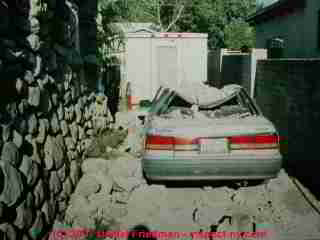
Combination of movements due to earthquake damage is demonstrated by the photograph above of an un reinforced stone masonry foundation and wall home in California. Un reinforced concrete structures are no longer permitted by California building codes for construction in areas of earthquake risk.
Below: new foundation construction in Christchurch, New Zealand in 2014. Heavy re-bar use in slabs and foundation walls is designed to control damage in future earthquakes.
Earthquake Damage Assessment & Repair References
- Aguilar, Antoio, The SEISMIC REHABILITATION of HISTORIC BUILDINGS [PDF] Preservation Brief No. 41, U.S. National Park Service, Technical Preservation Services, retrieved 2022/10/08 original source: https://www.nps.gov/tps/how-to-preserve/briefs/41-seismic-rehabilitation.htm
Excerpt:
This Preservation Brief provides information on how earthquakes affect historic buildings, how a historic preservation ethic can guide responsible retrofit decisions, and how various methods of seismic rehabilitation can protect human lives and historic structures.
The Brief provides a description of the most common vulnerabilities of various building construction types and the seismic strengthening methods most often needed to remedy them. A glossary of technical terms is also provided at the end of the Brief. - HUD, Chapter 6 LATERAL RESISTANCE to WIND and EARTHQUAKE [PDF] - U.S. Department of Housing & Urban Development, - retrieved 2022/05/28, original source: https://www.huduser.gov/publications/pdf/res2000_3.pdf - Shearwalls
- Simpson Strong-Tie, SEISMIC RETROFIT GUIDE for RAISED FOUNDATIONS [PDF] (2019) Simpson Strong Tie®, retrieved 2020/11/23, original source: https://www2.strongtie.com/catalog_order.asp?site=SST where you can download any of a large collection of reference documents, catalogs, and product guides from Simpson Strong-Tie.
- Simpson Strong-tie STRONG-FRAME DESIGN GUIDE for MOMENT FRAME DESIGNS [PDF] (2020) Simpson Strong Tie®, retrieved 2020/11/23, original source: https://www2.strongtie.com/catalog_order.asp?site=SST where you can download any of a large collection of reference documents, catalogs, and product guides from Simpson Strong-Tie.
- Simpson Strong-tie STRONG-ROD SYSTEMS SEISMIC & WIND RESTRAINT SYSTEMS GUIDE [PDF] (2020) Simpson Strong Tie®, retrieved 2020/11/23, original source: https://www2.strongtie.com/catalog_order.asp?site=SST where you can download any of a large collection of reference documents, catalogs, and product guides from Simpson Strong-Tie.
- Simpson Strong-Tie STRONG-ROD SYSTEMS SEISMIC & WIND ANCHOR TIEDOWN SYSTEM GUIDE (Canada) [PDF] (2018) Simpson Strong Tie®, retrieved 2020/11/23, original source: https://www2.strongtie.com/catalog_order.asp?site=SST where you can download any of a large collection of reference documents, catalogs, and product guides from Simpson Strong-Tie.
- Simpson Strong-tie STRONG-WALL SHEARWALLS [PDF] (2020) for wood shearwalls, Simpson Strong Tie®, retrieved 2020/11/23, original source: https://www2.strongtie.com/catalog_order.asp?site=SST where you can download any of a large collection of reference documents, catalogs, and product guides from Simpson Strong-Tie.
- [1] Arakida, Masaru. "Measuring vulnerability: The ADRC perspective for the theoretical basis and principles of indicator development." Measuring Vulnerability to Natural Hazards–towards disaster resilient societies, United Nations University Press, Tokyo (2006): 290-299.
- [2] Comerio, Mary C. "Public policy for reducing earthquake risks: a US perspective." Building Research & Information 32, no. 5 (2004): 403-413.
- [3] Kamat, Vineet R., and Sherif El-Tawil. "Evaluation of augmented reality for rapid assessment of earthquake-induced building damage." Journal of computing in civil engineering 21, no. 5 (2007): 303-310.
- [4] Kovacs, Paul. Reducing the risk of earthquake damage in Canada: Lessons from Haiti and Chile. Institute for Catastrophic Loss Reduction, 2010.
- [5] Mills, Evan, Evan Mills, and Ivo Knoepfel. Energy-efficiency options for insurance loss prevention. Environmental Energy Technologies Division, Ernest Orlando Lawrence Berkeley National Laboratory, 1997.
- [6] Noji, Eric K., and Keith T. Sivertson. "Injury prevention in natural disasters. A theoretical framework." Disasters 11, no. 4 (1987): 290-296.
- [7] Peek-Asa, Coritme, Jess F. Kraus, Linda B. Bourque, Dushyanthi Vimalachandra, Jenny Yu, and Jackie Abrams. "Fatal and hospitalized injuries resulting from the 1994 Northridge earthquake." International Journal of Epidemiology 27, no. 3 (1998): 459-465.
- [8] John Tagliabue, Parts of Low Country Are Now Quake Country", The New York Times, 27 March 2013, p. A6.
- [12] Henry Fountain, "Experts Eye Oil and Gas Industry as Quakes Shake Oklahoma", The New York Times, 13 December 2013, p. A20, A23.
- [13] Stein, Ross S. "The role of stress transfer in earthquake occurrence." Nature 402, no. 6762 (1999): 605-609. US Geological Survey, MS 977, Menlo Park, California 94025, USA , Email: rstein@usgs.gov.
- [14] Lin, Jian, and Ross S. Stein. "Stress triggering in thrust and subduction earthquakes and stress interaction between the southern San Andreas and nearby thrust and strike‐slip faults." Journal of Geophysical Research: Solid Earth (1978–2012) 109, no. B2 (2004).
- [15] Parsons, Tom, Ross S. Stein, Robert W. Simpson, and Paul A. Reasenberg. "Stress sensitivity of fault seismicity: A comparison between limited‐offset oblique and major strike‐slip faults." Journal of Geophysical Research: Solid Earth (1978–2012) 104, no. B9 (1999): 20183-20202.
- [16] Toda, Shinji, Jian Lin, Mustapha Meghraoui, and Ross S. Stein. "12 May 2008 M= 7.9 Wenchuan, China, earthquake calculated to increase failure stress and seismicity rate on three major fault systems." Geophysical Research Letters 35, no. 17 (2008).
- [17] Parsons, Tom, and Douglas S. Dreger. "Static‐stress impact of the 1992 Landers earthquake sequence on nucleation and slip at the site of the 1999 M= 7.1 Hector Mine earthquake, southern California." Geophysical research letters 27, no. 13 (2000): 1949-1952.
- [18] King, G. C. P., and M. Cocco. "Fault interaction by elastic stress changes: New clues from earthquake sequences." Advances in Geophysics 44 (2001): 1-VIII.
- [19] Toda, Shinji, and Ross Stein. "Toggling of seismicity by the 1997 Kagoshima earthquake couplet: A demonstration of time-dependent stress transfer." Journal of geophysical research 108, no. B12 (2003): 2567.
- [20] Simpson, Robert W., and Paul A. Reasenberg. "Earthquake-induced static stress changes on central California faults." US Geol. Surv. Prof. Pap 55 (1994): 89.
- [21] Cocco, Massimo, Concetta Nostro, and G. Ekström. "Static stress changes and fault interaction during the 1997 Umbria-Marche earthquake sequence." Journal of seismology 4, no. 4 (2000): 501-516.
- [22] Zeng, Yuehua. "Viscoelastic stress‐triggering of the 1999 Hector Mine Earthquake by the 1992 Landers Earthquake." Geophysical research letters 28, no. 15 (2001): 3007-3010.
- [23] Toda, Shinji, Jian Lin, and Ross S. Stein. "Using the 2011 M= 9.0 Tohoku earthquake to test the Coulomb stress triggering hypothesis and to calculate faults brought closer to failure." Earth Planets Space 63 (2011): 1-6.
- [24] Freed, Andrew M. "Earthquake triggering by static, dynamic, and postseismic stress transfer." Annu. Rev. Earth Planet. Sci. 33 (2005): 335-367. Quoting:
Earthquake triggering is the process by which stress changes associated with an earthquake can induce or retard seismic activity in the surrounding region or trigger other earthquakes at great distances. Calculations of static Coulomb stress changes associated with earthquake slip have proven to be a powerful tool in explaining many seismic observations, including aftershock distributions, earthquake sequences, and the quiescence of broad, normally active regions following large earthquakes.
Delayed earthquake triggering, which can range from seconds to decades, can be explained by a variety of time-dependent stress transfer mechanisms, such as viscous relaxation, poroelastic rebound, or afterslip, or by reductions in fault friction, such as predicted by rate and state constitutive relations.
Rapid remote triggering of earthquakes at great distances (from several fault lengths to 1000s of km) is best explained by the passage of transient (dynamic) seismic waves, which either immediately induce Coulomb-type failure or initiate a secondary mechanism that induces delayed triggering. The passage of seismic waves may also play a significant role in the triggering of near-field earthquakes. - [25] " Man-made earthquake strikes Christchurch ", The New Zealand Herald, 17 April 2012, Quoting: Man-made earthquake strikes Christchurch 3:58 PM Tuesday Apr 17, 2012 A magnitude 4 earthquake is to strike Christchurch - but this one will be man-made. The "earthquake" struck at 11.30am, at QEII Stadium, at a depth of up to 12km. The jolt is part of tests by the Earthquake commission into whether liquefaction-prone land in the east of the city can be repaired. About 25 small underground explosives are to be placed up to 12 metres deep and set off to simulate an earthquake of about magnitude 4.
- [26] William Ellsworth (ellsworth@usgs.gov), Jessica Robertson (jrobertson@usgs.gov), and Christopher Hook (703-648-4460), "Man-Made Earthquakes Update", USGS, 12 July 2013, retrieved 13 December 2013, original source: http://www.usgs.gov/blogs/features/usgs_top_story/man-made-earthquakes/
- [27] Katie M. Keranen, Heather M. Savage, Geoffrey A. Abers and Elizabeth S. Cochran, "Potentially induced earthquakes in Oklahoma, USA: Links between wastewater injection and the 2011 Mw 5.7 earthquake", Geology, January 2013, retrieved 12/13/2013, original source: http://geology.gsapubs.org/content/early/2013/03/26/G34045.1.abstract
Quoting from the abstract:
Significant earthquakes are increasingly occurring within the continental interior of the United States, including five of moment magnitude (Mw) ≥ 5.0 in 2011 alone. Concurrently, the volume of fluid injected into the subsurface related to the production of unconventional resources continues to rise.
Here we identify the largest earthquake potentially related to injection, an Mw 5.7 earthquake in November 2011 in Oklahoma. The earthquake was felt in at least 17 states and caused damage in the epicentral region. It occurred in a sequence, with 2 earthquakes of Mw 5.0 and a prolific sequence of aftershocks.
We use the aftershocks to illuminate the faults that ruptured in the sequence, and show that the tip of the initial rupture plane is within ∼200 m of active injection wells and within 1 km of the surface; 30% of early aftershocks occur within the sedimentary section.
Subsurface data indicate that fluid was injected into effectively sealed compartments, and we interpret that a net fluid volume increase after 18 yr of injection lowered effective stress on reservoir-bounding faults. Significantly, this case indicates that decades-long lags between the commencement of fluid injection and the onset of induced earthquakes are possible, and modifies our common criteria for fluid-induced events.
The progressive rupture of three fault planes in this sequence suggests that stress changes from the initial rupture triggered the successive earthquakes, including one larger than the first. - [28] David J. Hayes, "Is the Recent Increase in Felt Earthquakes in the Central US Natural or Manmade?", David J. Hayes, Deputy Secretary, U.S. Department of the Interior, DOI News, retrievedf 12/13/2013, original source: http://www.doi.gov/ news/doinews/Is-the-Recent-Increase-in-Felt-Earthquakes -in-the-Central-US-Natural-or-Manmade.cfm
- Wiley, Kip HISTORY of CALIFORNIA SEISMIC COMMISSION [PDF] (2000) Seismic Safety Commission,
- Also seeReferences or Citations located at the end of this article
Reader Comments, Questions & Answers About The Article Above
Below you will find questions and answers previously posted on this page at its page bottom reader comment box.
Reader Q&A - also see RECOMMENDED ARTICLES & FAQs
Question: our newly built townhouse vibrates and shudders and we hear banging
Just moved in to a new build town house which vibrates constantly and suffers with shuddering (top/3rd floor more noticeable with windows also shaking). On ground floor can sometimes hear banging, like someone has jumped or dropped heavy object from above. On a main road but this does not always happen when heavy vehicle drives past. Also suffering noise from pipes/ventilation outlets. - Lesley Anne 12/29/2011
Reply:
Lesley:
If the building movement and noises you describe were due to an earthquake or ongoing temblers or tremors, you could quickly confirm that condition with your local emergency services departments and building department, or perhaps even neighbors, as other buildings would be experiencing symptoms as well.
If that is not the case, then what you describe sounds specific to your individual building. Because some building movements, vibrations, and sounds can be symptoms of a pending catastrophic collapse, it makes sense to ask for expert advice promptly. An expert will listen to your concerns and will make his/her own thorough inspection of the structure both outdoors and inside, looking for
Indications of actual building movement and related damage, such as cracks, separation of framing, sticking windows or doors, floors or ceilings out of level, walls out of plumb.
Indications of foundation movement or damage such as cracks, leans, bulges, bows.
The purpose of the initial assessment of building condition will focus on the discovery of signs of an immediate life safety hazard. If that sort of hazard is comfortably ruled out, what remains may be construction methods and materials issues to review with the building owner, contractor, or an independent professional structural or civil engineer who is familiar with the type of construction used for your building.
Keep us posted, what you learn may assist other readers.
...
Continue reading at EARTHQUAKES, MAN-MADE or select a topic from the closely-related articles below, or see the complete ARTICLE INDEX.
Or see these
Recommended Articles
- BUILDING DAMAGE ASSESSMENT & REPAIR
- EARTHQUAKE DAMAGE - home
- FLOOD DAMAGE CLEANUP & REPAIR GUIDE
- HURRICANE DAMAGED BUILDINGS
- MODULAR METAL ROOF SHINGLE SYSTEM - earthquake warning comments related to metal roof noise
- SINKHOLES, WARNING SIGNS
- STRUCTURAL INSPECTIONS & DEFECTS
- WIND DAMAGED BUILDINGS
Suggested citation for this web page
EARTHQUAKE DAMAGE - home at InspectApedia.com - online encyclopedia of building & environmental inspection, testing, diagnosis, repair, & problem prevention advice.
Or see this
INDEX to RELATED ARTICLES: ARTICLE INDEX to BUILDING DAMAGE, DISASTER, REPAIRS
Or use the SEARCH BOX found below to Ask a Question or Search InspectApedia
Or see
INDEX to RELATED ARTICLES: ARTICLE INDEX to BUILDING STRUCTURES
Or use the SEARCH BOX found below to Ask a Question or Search InspectApedia
Ask a Question or Search InspectApedia
Try the search box just below, or if you prefer, post a question or comment in the Comments box below and we will respond promptly.
Search the InspectApedia website
Note: appearance of your Comment below may be delayed: if your comment contains an image, photograph, web link, or text that looks to the software as if it might be a web link, your posting will appear after it has been approved by a moderator. Apologies for the delay.
Only one image can be added per comment but you can post as many comments, and therefore images, as you like.
You will not receive a notification when a response to your question has been posted.
Please bookmark this page to make it easy for you to check back for our response.
Our Comment Box is provided by Countable Web Productions countable.ca
Citations & References
In addition to any citations in the article above, a full list is available on request.
- [9] "A Foundation for Unstable Soils," Harris Hyman, P.E., Journal of Light Construction, May 1995
- [10] "Backfilling Basics," Buck Bartley, Journal of Light Construction, October 1994
- [11] "Inspecting Block Foundations," Donald V. Cohen, P.E., ASHI Reporter, December 1998. This article in turn cites the Fine Homebuilding article noted below.
- Building Failures, Diagnosis & Avoidance, 2d Ed., W.H. Ransom, E.& F. Spon, New York, 1987 ISBN 0-419-14270-3
- Domestic Building Surveys, Andrew R. Williams, Kindle book, Amazon.com
- Defects and Deterioration in Buildings: A Practical Guide to the Science and Technology of Material Failure, Barry Richardson, Spon Press; 2d Ed (2001), ISBN-10: 041925210X, ISBN-13: 978-0419252108. Quoting:
A professional reference designed to assist surveyors, engineers, architects and contractors in diagnosing existing problems and avoiding them in new buildings. Fully revised and updated, this edition, in new clearer format, covers developments in building defects, and problems such as sick building syndrome. Well liked for its mixture of theory and practice the new edition will complement Hinks and Cook's student textbook on defects at the practitioner level. - Guide to Domestic Building Surveys, Jack Bower, Butterworth Architecture, London, 1988, ISBN 0-408-50000 X
- "Avoiding Foundation Failures," Robert Marshall, Journal of Light Construction, July, 1996 (Highly recommend this article-DF)
- "When Block Foundations go Bad," Fine Homebuilding, June/July 1998
- "Concrete Slab Finishes and the Use of the F-number System", Matthew Stuart, P.E., S.E., F.ASCE, online course at www.pdhonline.org/courses/s130/s130.htm
- Sal Alfano - Editor, Journal of Light Construction*
- Thanks to Alan Carson, Carson Dunlop, Associates, Toronto, for technical critique and some of the foundation inspection photographs cited in these articles
- Terry Carson - ASHI
- Mark Cramer - ASHI
- JD Grewell, ASHI
- Duncan Hannay - ASHI, P.E. *
- Bob Klewitz, M.S.C.E., P.E. - ASHI
- Ken Kruger, P.E., AIA - ASHI
- Bob Peterson, Magnum Piering - 800-771-7437 - FL*
- Arlene Puentes, ASHI, October Home Inspections - (845) 216-7833 - Kingston NY
- Greg Robi, Magnum Piering - 800-822-7437 - National*
- Dave Rathbun, P.E. - Geotech Engineering - 904-622-2424 FL*
- Ed Seaquist, P.E., SIE Assoc. - 301-269-1450 - National
- Dave Wickersheimer, P.E. R.A. - IL, professor, school of structures division, UIUC - University of Illinois at Urbana-Champaign School of Architecture. Professor Wickersheimer specializes in structural failure investigation and repair for wood and masonry construction. * Mr. Wickersheimer's engineering consulting service can be contacted at HDC Wickersheimer Engineering Services. (3/2010)
- *These reviewers have not returned comment 6/95
- Avongard FOUNDATION CRACK PROGRESS CHART [PDF] - structural crack monitoring
- Building Pathology, Deterioration, Diagnostics, and Intervention, Samuel Y. Harris, P.E., AIA, Esq., ISBN 0-471-33172-4, John Wiley & Sons, 2001 [General building science-DF] ISBN-10: 0471331724 ISBN-13: 978-0471331728
- Building Pathology: Principles and Practice, David Watt, Wiley-Blackwell; 2 edition (March 7, 2008) ISBN-10: 1405161035 ISBN-13: 978-1405161039
- Diagnosing & Repairing House Structure Problems, Edgar O. Seaquist, McGraw Hill, 1980 ISBN 0-07-056013-7 (obsolete, incomplete, missing most diagnosis steps, but very good reading; out of print but used copies are available at Amazon.com, and reprints are available from some inspection tool suppliers). Ed Seaquist was among the first speakers invited to a series of educational conferences organized by D Friedman for ASHI, the American Society of Home Inspectors, where the topic of inspecting the in-service condition of building structures was first addressed.
- Design of Wood Structures - ASD, Donald E. Breyer, Kenneth Fridley, Kelly Cobeen, David Pollock, McGraw Hill, 2003, ISBN-10: 0071379320, ISBN-13: 978-0071379328
This book is an update of a long-established text dating from at least 1988 (DJF); Quoting:
This book is gives a good grasp of seismic design for wood structures. Many of the examples especially near the end are good practice for the California PE Special Seismic Exam design questions. It gives a good grasp of how seismic forces move through a building and how to calculate those forces at various locations. THE CLASSIC TEXT ON WOOD DESIGN UPDATED TO INCLUDE THE LATEST CODES AND DATA. Reflects the most recent provisions of the 2003 International Building Code and 2001 National Design Specification for Wood Construction. Continuing the sterling standard set by earlier editions, this indispensable reference clearly explains the best wood design techniques for the safe handling of gravity and lateral loads. Carefully revised and updated to include the new 2003 International Building Code, ASCE 7-02 Minimum Design Loads for Buildings and Other Structures, the 2001 National Design Specification for Wood Construction, and the most recent Allowable Stress Design. - In addition to citations & references found in this article, see the research citations given at the end of the related articles found at our suggested
CONTINUE READING or RECOMMENDED ARTICLES.
- Carson, Dunlop & Associates Ltd., 120 Carlton Street Suite 407, Toronto ON M5A 4K2. Tel: (416) 964-9415 1-800-268-7070 Email: info@carsondunlop.com. Alan Carson is a past president of ASHI, the American Society of Home Inspectors.
Thanks to Alan Carson and Bob Dunlop, for permission for InspectAPedia to use text excerpts from The HOME REFERENCE BOOK - the Encyclopedia of Homes and to use illustrations from The ILLUSTRATED HOME .
Carson Dunlop Associates provides extensive home inspection education and report writing material. In gratitude we provide links to tsome Carson Dunlop Associates products and services.


